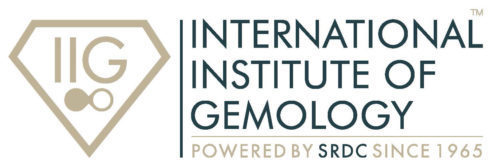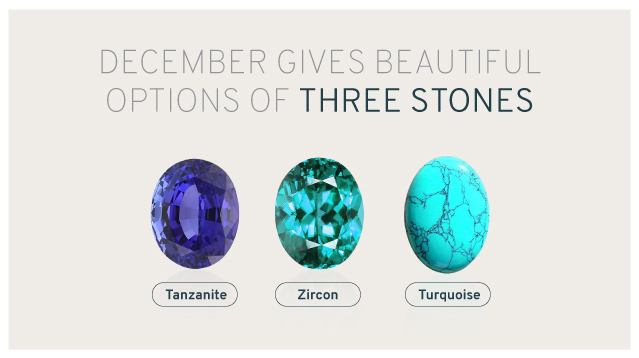December—end of the calendar year –ends with Tanzanite, Turquoise & Zircon as their Birthstones.
All three December birthstones carry a unique blue tone where in most popular is turquoise and on expensive side is Tanzanite, Zircon being the third option.

Tanzanite – expensive & rare December Birthstone
The blue zoisite, otherwise found brownish in nature, is a heated version which attracted many for being so close to have similar catchy blue colour like that of Kashmir Blue sapphire and is available in the market on demand compared to a rarer counterpart – Kashmir Blue Sapphire.
Tanzanite is mainly mined around Arusha—Tanzania, hence the mineral is named Tanzanite.
It falls under Epidote family as Brownish zoisite with violet to purple undertone. Heating this zoisite, pseudo brown colour disappears and the undertone takes over the main colour of the material. Colouring element is Vanadium. Tanzanite known as `Tz’ in local market belongs to orthorhombic crystal system which makes it so lustrous and attractive like their other crystal system minerals.
Tz is softer for having 6-6.5H on Moh`s Hardness scale. It means it attracts utmost care while setting in the jewellery pc and need to avoid direct contact with corrosive chemicals, including heat.
Tz is available in all shapes and size with more height of the stone than other usual ones to have deep and lustrous look. Darker colour towards blue fetches better price. Blue tone is more preferred to violet in general but it still depends on a designer as they create saleable products.
Tz also wear as tumbled bead necklace wherein more emphasis is given on colour than clarity. Also cabs are preferred for entangled jewellery pieces.
Tz mined from Mererani Hills near Arusha in form of rough mineral is supplied as sights to their esteemed buyers by TanzaniteOne in same way as diamond rough sites by DTC.
Lab created Blue sapphire with lighter and dark blue colours are sold as Tanzalite in the market as cheaper look alike.
Tz came into limelight through the Hollywood movie – Titanic, and ever since it’s most sought after gemstones among Americans and Europeans.


Turquoise – oldest to modern December Birthstone
Turquoise is a part of Victorian jewellery since ages and also in vogue today too.
Turquoise is found in greenish blue to bluish green to sky blue colour shades but opaque in clarity. It falls under triclinic crystal system and hence doesn’t show distinct crystal formation and are found as nodes or in a massive form. Colour is because of copper which is part of chemical composition. Most common shapes are beads, cabs, carvings.
Most preferred colour is sky blue which comes from Persia (Iran) and nowadays from Arizona – Kingman Mine – sold as Sleeping Beauty Turquoise. Greenish blue variety comes from Tibet where it is worshipped as sacred stone. Bluish green variety comes from Egypt.
Because of nodular nature, many a times the outer visible surface shows dimpling dents which are filled with similar colour resins which is normal and undisclosed practice in fashion market.
Turquoise are found between mother rock plates so most times they are cut and polished along with mother rock to save genuine color mineral and are sold as Turquoise with matrix. This matrix if forms spider web type pattern than it’s in great demand.
Chinese turquoise, a synthetic turquoise with golden web pattern/ matrix are simulated and synthetic version, much used in fashion jewellery.
Generally, natural turquoise doesn’t have uniform single colour which is not found in their synthetic counterpart, making latter easy to distinguish.
Turquoise is worn for Jupiter planet in Muslim community and is very sacred for them.
Being massive in nature, thinner slices or cabs are possible which have tendency to break and hence they are backed with shellac layer which gives strength to the piece.
Turquoise blue is a distinct colour and most liked colour by fashion industry and so does Turquoise for jewellery.

Zircon – Matara Diamond –Third December Birthstone
Zircon belongs to tetragonal crystal system and it’s very lustrous due its higher dispersive power than that of diamond.
Zircon is a source for zirconium metal.
Zircon falls under tetragonal crystal system and comes in all colours. It has adamantine lustre similar to that of diamond and so it’s been produce in lab with cubic crystal form as synthetic cubic zirconia as a cheaper alternative for the diamond.
Fashion Jewellery comprise mostly of synthetic CZ nowadays.
Preferred cuts are rounds and oval, reason being that zircons are brittle in nature and get abraded and chipped if comes in contact with any hard material. So pointed corner cuts are to be avoided.
Zircon has a hardness of 7.5H on Moh`s hardness scale so it can be used in jewellery with care.
Zircon sometimes contain uranium traces which alters the properties of zircon due to its radiations spread. Hence such traces as inclusions in Blue Sapphire coming from Sri Lanka are called `Zircon Halo’.
Simulants or look alike of Zircon are diamond, Herkimer diamond quartz, white sapphire, white topaz.
Zircon is preferred to diamond in North east India as a planetary stone. White, Blue & Brown are preferred in small rounds in western countries in designer jewellery.
Colourless zircon is often sold as Matara Diamond after the mine in Sri Lanka from where it`s mined.
Written by Rajesh Patel
Writer is a gemmologist, writer, teacher, mentor and humanitarian.
He deals in coloured gemstones and supply compliant goods.

